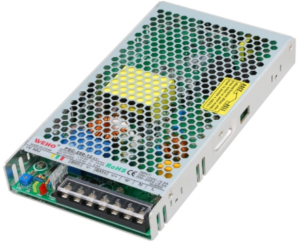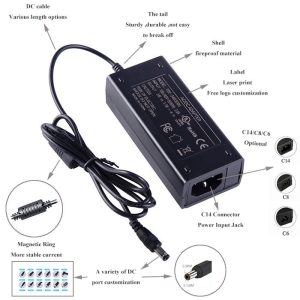When powering electronic devices, two common options emerge: switching power supplies and AC adapters. While both serve to convert AC (alternating current) from a wall outlet into DC (direct current) for devices, their design, efficiency, application, and cost can vary greatly. Understanding the differences and similarities between these two solutions is crucial for engineers, manufacturers, and consumers alike.
In this article, we’ll explore 3 similarities and 6 key differences to help you choose the right power supply for your needs.
Switching Power Supply vs AC Adapter: 3 Similarities
| Similarity | Description |
|---|---|
| Core Function | Both convert AC power to DC power to operate electronic devices. |
| AC Input Support | Both accept wide AC input range (100–240V), suitable for global use. |
| DC Output Voltage | Both provide common DC outputs like 5V, 12V, 24V, and 48V for various devices. |
Core Function
Both switching power supplies and AC adapters share the primary function of converting high-voltage AC input into low-voltage DC output. This is essential for powering devices such as routers, LED lights, industrial machines, and consumer electronics. Despite differences in size and performance, their goal is fundamentally the same—providing stable and safe DC power.
Common AC Input Requirement
Another similarity lies in the AC input range. Both types of power supplies typically support a universal input voltage, such as 100–240V AC, allowing them to function across regions with different electrical standards. This makes them widely applicable in both commercial and residential settings.
Direct Current Output
Regardless of internal construction, both deliver DC output voltage—commonly 5V, 12V, 24V, or 48V—suitable for powering a wide range of devices. They are designed to ensure low ripple, regulated voltage, and safe operation for connected equipment.
Switching Power Supply vs AC Adapter: 6 Key Differences
| Aspect | Switching Power Supply | AC Adapter |
|---|---|---|
| Efficiency | High efficiency (varies by load and design); ideal for industrial use | WeHo AC adapters offer >90% efficiency; suitable for consumer electronics |
| Size & Weight | Bulkier and heavier; enclosed in metal casing for higher power applications | Compact and lightweight; ideal for portable and small-scale devices |
| Working Principle | Adjustable output, better heat dissipation, industrial-grade features | Fixed output, simple design, sealed for safety and ease of use |
| Noise | May generate noise or EMI; quality models reduce it through design | Optimized for low-noise environments like homes and offices |
| Cost | Higher cost, but more flexible and durable for demanding environments | More affordable due to simpler construction and lower power ratings |
| Lifespan | Longer lifespan; WeHo offers 3-year warranty | Shorter lifespan; WeHo provides 1-year warranty |
Efficiency
Efficiency is a critical factor in power supply selection. AC adapters are generally used in consumer applications, but premium brands like WeHo AC adapters boast high efficiency over 90%, which minimizes energy waste and heat generation. In contrast, switching power supplies are often optimized for industrial applications and also deliver high efficiency, though specific performance depends on load conditions and design.
Size and Weight
AC adapters are usually compact and lightweight, designed for portability and convenience—ideal for powering laptops, cameras, or small electronics. In contrast, switching power supplies tend to be larger and heavier, especially those with higher wattage ratings or enclosed metal cases used in automation and control systems.
Working Principles
While both are classified as “switch-mode” devices in many cases, there’s a subtle difference in internal design:
-
AC adapters often use a sealed enclosure with minimal user interaction, typically featuring pre-set voltage and current limits.
-
Switching power supplies offer more flexibility, including adjustable output voltage, programmable control, and better heat dissipation, making them suitable for industrial automation, CNC systems, and LED lighting systems.
Noise Characteristics
Switching power supplies, especially in high-frequency or high-load conditions, may produce audible noise or electromagnetic interference (EMI). AC adapters, on the other hand, are usually optimized for low-noise environments like offices or homes. However, quality brands like WeHo engineer their power supplies to meet EMI standards and minimize operational noise.
Cost
Cost is often a deciding factor. AC adapters are generally more affordable, due to their simpler design and lower output capacities. Switching power supplies, while pricier, deliver greater flexibility, durability, and customization, especially for industrial-grade applications. Long-term cost-effectiveness depends on use case and expected service life.
Lifespans
Durability matters, especially in professional applications. WeHo AC adapters come with a 1-year warranty, ideal for general consumer electronics. On the other hand, WeHo switching power supplies offer a 3-year warranty, reflecting their longer lifespan and robust construction designed for industrial use and harsh environments.
Conclusion
Choosing between a switching power supply and an AC adapter depends largely on your application requirements. If you need a compact, cost-effective power source for home electronics, an AC adapter may be ideal. However, for higher power needs, better control, and longer durability, a switching power supply is the better choice. Brands like WeHo offer high-efficiency solutions across both categories, backed by solid warranties and industry-grade reliability.
By understanding the 3 similarities and 6 differences, you can make an informed decision and ensure the best performance for your devices.










